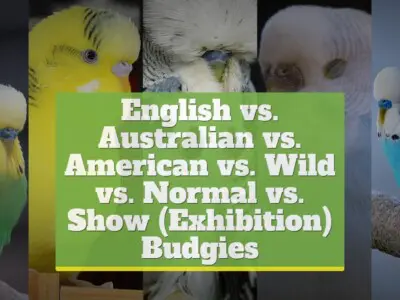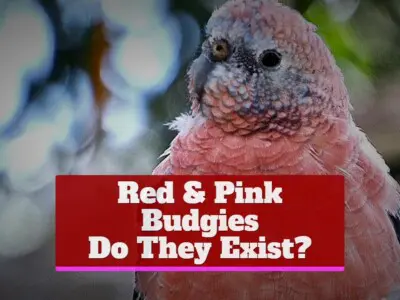Gray budgies exist and are results of genetic mutations, specifically the Australian and English Gray Mutations.
Australian Gray Budgies tend to exhibit a lighter, silvery color while English Gray Budgies have a darker shade.
However, they are not considered rare, as these mutations are quite common in captivity.
As someone who holds a deep love for birds, especially budgies, I’ve created this content to delve into the captivating world of gray budgies.
This information will be beneficial for bird enthusiasts who share a similar curiosity and fascination for these beautiful creatures.

The genetic world of budgies is a mesmerizing one.
The different shades of grey, be it light, medium, or dark, have a long history that takes us back to the 1930s.
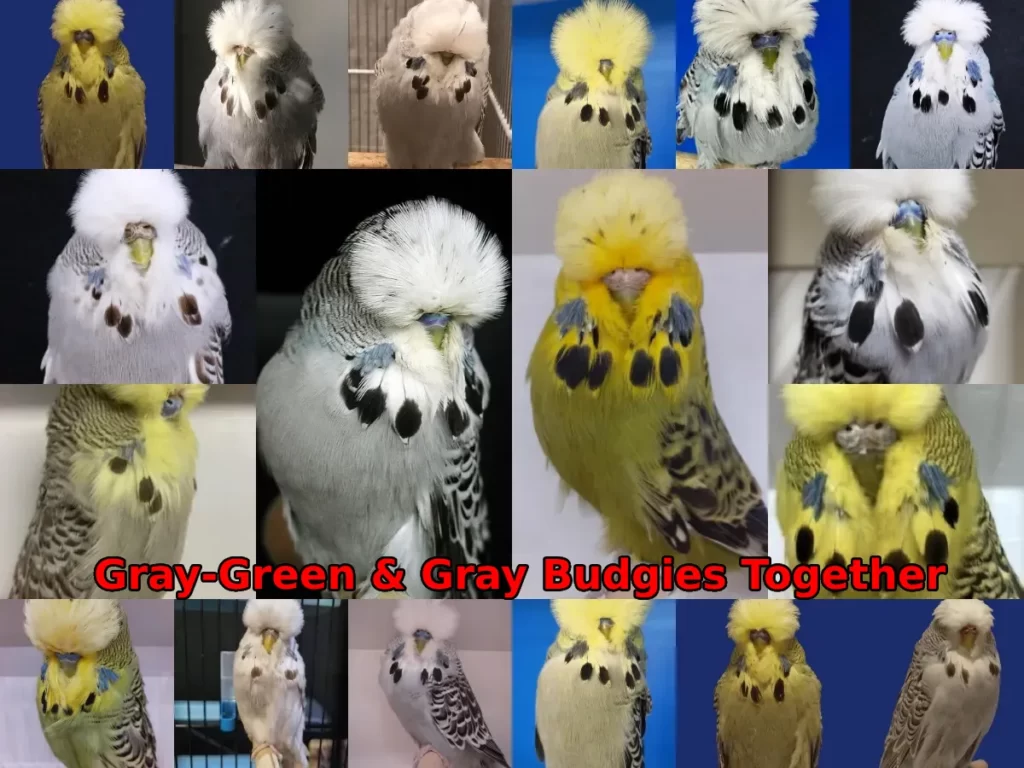
It all began in Murrumbeena, Victoria, when Mrs. S. Harrison first recognized the Gray variety in a bird she acquired from a dealer in 1935.
It wasn’t long before she established a lineage of Greys, each with varying shades and distinct black tail and wing markings.
The Australian Grey, as we now know it, was born.
The unique Gray mutation emerged in England around the same time, yet it had a different genetic characteristic, despite their visual similarity.
Unlike the dominant Australian Grey, the English Gray mutation was recessive.
The continuation of this recessive mutation remains a mystery.
However, the gray factor does not stop with these mutations alone.
It contributes to the development of the Gray Greens when added to the green series.
Interestingly, these budgies, like the original Greys, also appear in three distinct shades, making them quite popular among bird lovers.
The captivating world of gray budgies takes another turn with the advent of a new gray mutation, the anthracite, which appeared in Germany in 1998 in the aviaries of Hans Lenk.
A bird with two anthracite factors presents an extremely dark gray body with jet black markings, leading to a captivating contrast.
The intricate world of gray budgie mutations is indeed vast, each unveiling its unique genetic journey and color spectrum.
As a bird lover, this is a fascinating tale of nature’s spectacular show of colors and genetic variations.
However, let’s remember that while we’re appreciating their beauty, it’s equally crucial to ensure their well-being and conservation.
After all, they’re not just a beautiful sight to behold; they’re delicate creatures deserving of our love and respect.
Mutations Or Combinations That Cause A Budgie To Appear Gray Color
Diving into the fascinating world of budgie color mutations, you can’t help but marvel at the myriad of colors these delightful birds can exhibit.
Color mutations in budgies are not just about their vibrant hues but involve the interplay of various genetic factors, each contributing to the final appearance of the bird.
You’ve likely seen or heard about gray budgies, and these captivating creatures owe their unique coloration to certain genetic mutations or combinations.
Let’s unearth the mysteries of these mutations and how they cause our feathered friends to exhibit that captivating gray color.
An important term to remember when discussing budgie color mutations is “factor”.
A factor, in genetic terms, refers to a specific trait’s gene.
Each color or pattern we see in a budgie is the result of these factors working together, influenced by dominant or recessive inheritance patterns.
Australian Gray Mutation (Gray Factor)
Now, let’s focus our attention on a specific gray mutation that was first recognized in Australia – the Australian Gray mutation.
This mutation traces its roots back to 1935, when Mrs. S. Harrison of Murrumbeena, Victoria, noticed a peculiar gray bird she had obtained from a dealer.
The pedigree of this bird was unknown, but what was clear was its distinct coloration.
It was different, it was unique, it was grey.
Mrs. Harrison worked tirelessly to establish this variety, eventually breeding Gray budgies in several shades, from light to medium to dark.
Besides the gray body, these birds have a defining feature – the dense, black color of their tail and wing markings.
This stark contrast further enhances their overall gray coloration, creating a captivating visual.
This dominant mutation, now widely recognized as the Australian Grey, has continued to charm budgie enthusiasts across the globe.
When this gray factor is combined with the green series, it results in the very popular Gray Greens, which also appear in three different shades.
These budgies serve as living testaments to Mrs.
Harrison’s keen eye and dedicated breeding efforts.
In the realm of genetics, the Australian Gray mutation is considered dominant.
This means that even if a budgie only inherits the gray factor from one parent, it will still exhibit the gray coloration.
Such is the power of this dominant gene that it has helped to spread the gray coloration in budgies far and wide, enabling more and more people to appreciate the beauty of gray budgies.
English Gray Mutation (Gray Factor)
While the Australian Gray mutation represents a significant chapter in the story of gray budgies, another captivating tale emerges on the other side of the globe.
Welcome to the world of the English Gray mutation, another variant of the gray factor in budgerigars.
Just as captivating and mesmerizing as their Australian counterparts, English Greys hold their unique place in the realm of budgie color mutations.
The English Gray mutation, as the name suggests, was first noted in England around the 1940s.
This mutation also affects the usual coloration of the budgie, turning it to various shades of grey.
However, what sets this mutation apart from the Australian Gray is the color of the bird’s tail and wing markings.
Instead of dense, black markings, English Greys sport a more diluted, slate-gray color in their markings, offering a softer contrast to their overall gray body coloration.
Despite being less stark than the Australian Grey, the English Gray budgie has gained a steady following of breeders and enthusiasts, all charmed by its unique hues.
This recessive mutation has a softer, more understated elegance, a subtle beauty that speaks volumes about the genetic diversity among budgies.
Whether combined with the blue series to create the classic Grey budgies or the green series to produce the exquisite Gray Green variants, English Greys have proven their genetic versatility.
It’s worth noting that the English Gray is a recessive mutation, which means that a budgie must inherit the gray factor from both parents to exhibit this coloration.
While this might make the English Gray less common than its dominant Australian counterpart, it doesn’t detract from its appeal.
The rarity of the English Gray only adds to its allure, making each sighting of these delightful birds a treat for the eyes.
As budgie enthusiasts continue to delve into the world of color mutations, both the Australian and English Gray mutations serve as fascinating examples of the genetic diversity that makes these birds so captivating.
Gray Factor On Green Series: Gray Green Budgies
Now, let’s shift our focus to an interesting combination that results from the gray factor acting on the green series budgies – the Gray Green Budgies.
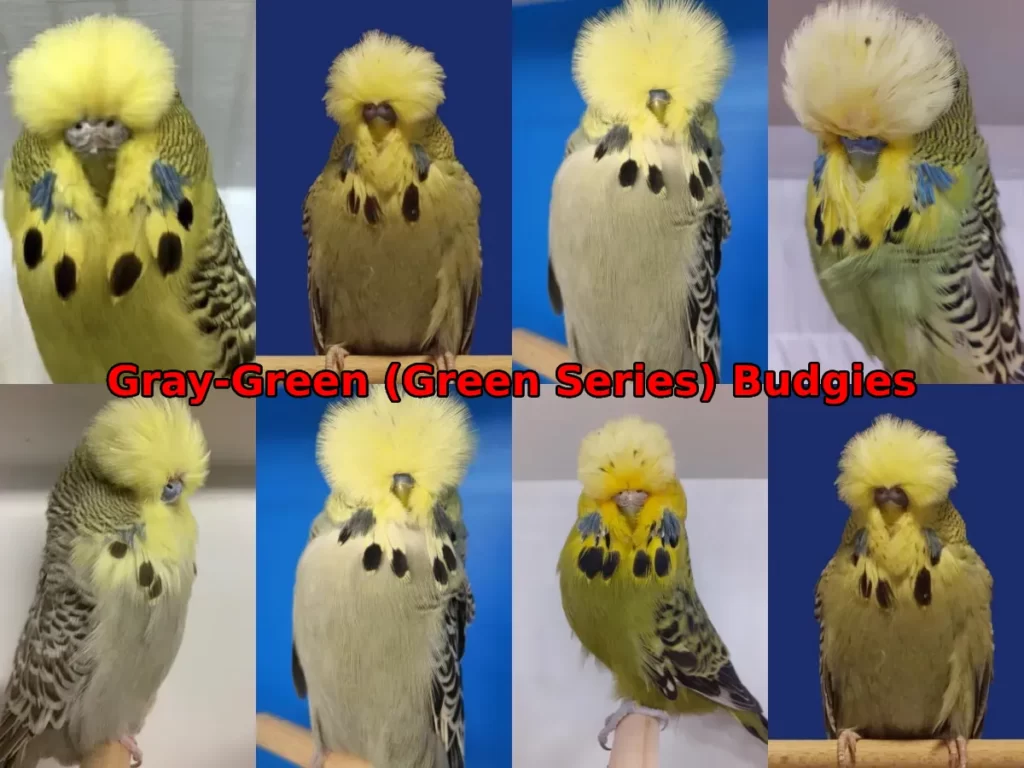
This intriguing amalgamation of green and gray not only gives us an array of aesthetically pleasing birds but also adds an additional layer to the complexity of budgie genetics.
Gray Green Budgies emerge from the intersection of the green series budgies and the gray factor.
When the gray factor comes into play with green series budgies, it lends a gray hue to the bird’s feathers, thus creating the Gray Green variant.
This variant is popular among breeders and bird enthusiasts alike, and its demand is proof of the bird’s exceptional appeal.
The striking color of the Gray Green Budgies is a delight to behold.
The green series budgie, possessing a vibrant, lush green color, undergoes a transformation under the influence of the gray factor.
The usual green feathers become washed with a greyish hue, presenting an unusual and attractive look that captivates onlookers.
The result is a budgie that possesses a unique charm and elegance, making it a much sought-after variety.
Gray Factor On Blue Series: Gray Budgies
Let’s move on to another captivating combination that emerges when the gray factor interacts with the blue series budgies – the Gray Budgies.
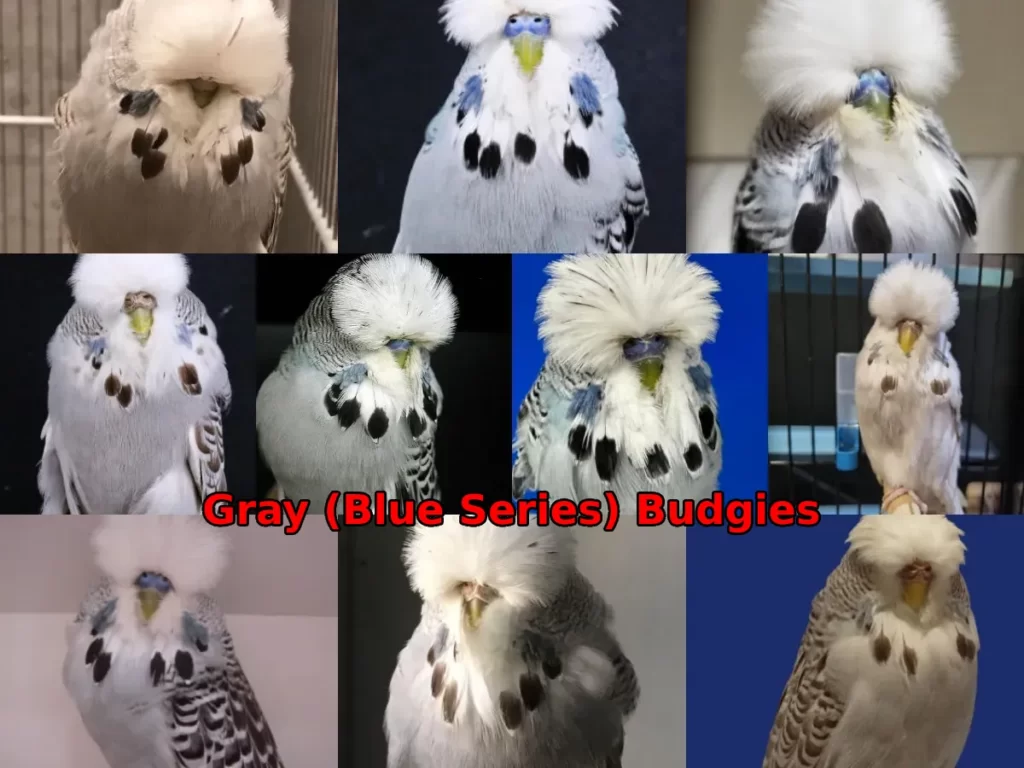
This fascinating combination shows us how the interplay of mutations can yield a stunning variety of budgerigar colors, highlighting the complexity and diversity of budgie genetics.
The origin of Gray Budgies lies in the application of the gray factor to blue series budgies.
This factor imparts a greyish tint to the originally blue feathers, resulting in the distinctive coloration that we recognize as Gray Budgies.
Whether for their unique coloration or the intriguing genetics behind their creation, these birds are certainly a notable part of the budgerigar family.
In terms of visual appeal, Gray Budgies have a unique charm.
The blue series budgie, known for its cool, tranquil blue hues, transforms dramatically with the addition of the gray factor.
This factor dulls the original blue color, overlaying it with a soft gray sheen.
The result is a calm, serene shade of gray that is strikingly beautiful in its simplicity.
This unusual coloration is a favorite among bird enthusiasts and adds a unique touch to any budgie collection.
A Further Gray Mutation: The Anthracite Mutation
Venturing deeper into the complexity of budgie color mutations, we encounter another gray mutation – the Anthracite Mutation.
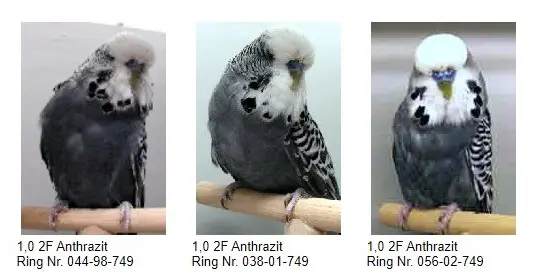
Unlike the traditional gray factor, this mutation results in a considerably darker and more intense shade of grey, earning it the name “Anthracite”.
It’s a captivating addition to the myriad of color variations found in budgerigars.
The Anthracite Mutation is a relatively rare mutation within budgies.
This mutation doesn’t merely add a gray hue to the bird’s coloration; it intensifies the depth and saturation of the gray color to a more profound level, resulting in a budgie that boasts a stunningly rich, coal-like color.
The transformation it induces is remarkable, leaving no doubt about the presence of this specific mutation.
Visually, Anthracite Budgies are an absolute spectacle.
Their dark, intense gray plumage, reminiscent of anthracite coal, offers a stark contrast to the lighter, softer shades of the traditional gray factor budgies.
This deep and intense coloration captivates onlookers, drawing the eye and earning these birds a special place in the hearts of bird enthusiasts and casual observers alike.
On the genetic level, the Anthracite Mutation is an autosomal recessive mutation.
This means that for a budgie to display this stunning coloration, it must inherit the Anthracite Mutation from both parents.
If a budgie receives this mutation from only one parent, it will be a carrier of the mutation, but it won’t exhibit the anthracite coloration.
This genetic subtlety can make the breeding of Anthracite Budgies a complex and intriguing endeavor.
Finally, the Anthracite Mutation serves as yet another reminder of the extraordinary diversity and intricacy found within budgie genetics.
Whether it’s the striking visual contrast it offers, or the complex genetic inheritance patterns it displays, the Anthracite Mutation adds a layer of depth and fascination to the exploration of budgie color mutations.
It’s a prime example of the genetic potential hidden within these delightful birds.
Faqs
How Do Gray Budgies Differ From Other Budgies?
Gray budgies differ from other budgies primarily in their coloration.
This distinct color results from specific genetic mutations known as the Australian and English Gray Mutations.
The Australian Gray mutation leads to a lighter, silver-gray color, while the English Gray mutation produces a darker, almost charcoal-like shade of grey.
What Is the Genetic Basis of Gray Budgies?
The unique color of gray budgies is a result of either the Australian or English Gray Mutation.
These mutations affect the distribution of melanin in the budgie’s feathers, causing them to appear grey.
The Australian mutation leads to a silvery hue, while the English mutation results in a darker gray color.
Are There Any Health Concerns Specific to Gray Budgies?
As of now, there are no known health issues specific to gray budgies that are related to their color mutation.
Like all budgies, their health is primarily influenced by their environment, diet, and care.
Can You Breed Gray Budgies?
Yes, you can breed gray budgies.
If both parent budgies carry the gray factor, there’s a good chance their offspring will also exhibit the gray coloration.
However, breeding should be done responsibly considering the birds’ health, genetic diversity, and care requirements.
How Can I Identify If a Budgie Is a True Gray Budgie?
Identifying a true gray budgie can be challenging for a novice but is relatively easy for experienced breeders.
True gray budgies will have a distinct gray coloration that is either light (Australian Grey) or dark (English Grey).
They should not be confused with diluted blue budgies, which might look gray but are genetically different.
Is the Australian Gray Mutation or English Gray Mutation Considered Rare?
While the Australian Gray Mutation and the English Gray Mutation in budgerigars are not as commonly seen as some other color variants, they would not necessarily be considered “rare.” These color variations occur due to the gray factor mutation, which influences the color of the feathers.
Their relative scarcity could be attributed more to breeding preferences and practices than to rarity in a genetic sense.
It’s important to note that the prevalence of different budgie colors can also vary by region and the specific breeding goals of budgie enthusiasts in those areas.
What Does Gray and Gray Green Refer to in the WBO Guide?
In the WBO Budgerigar Colour Guide, Gray and Gray Green refer to the light shade variations of these colours.
Gray Green is identified with Pantone code 398 and Gray with Pantone code 428.
These are precise references to these particular colour variants in budgerigars.
Why is the English Gray Mutation Rarer than the Australian Gray Mutation?
The reason why the English Gray Mutation is rarer than the Australian Gray Mutation in budgerigars comes down to genetics.
The Australian Gray mutation is dominant, meaning that only one copy of the gray gene is required for the budgie to exhibit the gray coloration.
However, the English Gray mutation is recessive, meaning that two copies of the gene (one from each parent) are needed for the gray coloration to appear.
This recessive nature makes the English Gray mutation less common, as it requires specific and deliberate breeding strategies to be propagated effectively.
